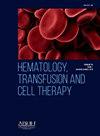Evaluation of hepcidin-25/erythroferrone ratio as a potential biomarker for iron utility and erythropoiesis responsiveness to erythropoiesis-stimulating therapy in comparison to immature erythrocyte/reticulocyte parameters in hemodialysis patients
IF 1.8
Q3 HEMATOLOGY
引用次数: 0
Abstract
Background
Anemia-associated chronic kidney disease increases in more advanced stages with a subsequent acceleration in renal impairment progressing to end-stage renal disease. Although hepcidin and erythroferrone have been described as novel biomarkers of iron metabolism, there is still an area of ambiguity regarding iron utility in anemia-associated end-stage renal disease.
Objectives
This study aims to determine the correlations between erythropoietin, erythroferrone, and hepcidin-25 in hemodialysis, and to evaluate the clinical utility of the hepcidin-25/erythroferrone ratio as a biomarker of erythropoiesis-stimulating agent effectiveness compared to reticulocyte maturation parameters.
Methods
Serum erythropoietin, erythroferrone, and hepcidin-25 levels in 35 dialysis-dependent patients on a maintenance dose of a short-acting erythropoiesis-stimulating agent were consequently assessed on Days 0, 5, and 7. The erythropoiesis activity was monitored by measuring the increment in reticulocyte maturation parameters.
Results
Though the effectiveness of erythropoiesis in these patients was not associated with the hepcidin-25/erythroferrone ratio, it was lower among those with effective erythropoiesis than those with ineffective erythropoiesis. The effective group showed a statistically significant increase in reticulocyte maturation parameters compared to the ineffective group.
Conclusions
The findings show the pathogenesis of iron homeostasis in hemodialysis, the validity of hepcidin-25/erythroferrone ratio as a biomarker of erythropoiesis-stimulating agent effectiveness, and the advantageous monitoring of reticulocyte maturation measures to improve management of anemia-associated chronic kidney disease.
与血液透析患者的未成熟红细胞/网织红细胞参数相比,评估血红素-25/红铁酮比值作为铁效用和红细胞生成对促红细胞生成疗法反应性的潜在生物标志物的作用。
背景:与贫血相关的慢性肾脏病越到晚期越严重,肾功能损害随之加速,最终发展为终末期肾脏病。尽管血红素和红铁酮已被描述为铁代谢的新型生物标志物,但在贫血相关终末期肾病中铁的效用方面仍存在模糊之处:本研究旨在确定血液透析中促红细胞生成素、红铁酮和 hepcidin-25 之间的相关性,并评估与网织红细胞成熟参数相比,hepcidin-25/红铁酮比值作为促红细胞生成素有效性生物标志物的临床实用性:在第 0 天、第 5 天和第 7 天,对 35 名使用短效促红细胞生成剂维持剂量的透析依赖型患者的血清促红细胞生成素、红铁酮和 hepcidin-25 水平进行了评估。通过测量网织红细胞成熟参数的增量来监测红细胞生成活性:结果:尽管这些患者的红细胞生成效果与血红素-25/高铁血红蛋白比率无关,但红细胞生成有效组的血红素-25/高铁血红蛋白比率低于红细胞生成无效组。与无效组相比,有效组的网织红细胞成熟参数有显著的统计学增长:结论:研究结果表明了血液透析中铁平衡的发病机制、血红细胞生成素-25/高铁血红蛋白比值作为红细胞生成刺激剂有效性生物标志物的有效性,以及监测网织红细胞成熟度对改善贫血相关慢性肾病管理的有利作用。
本文章由计算机程序翻译,如有差异,请以英文原文为准。
求助全文
约1分钟内获得全文
求助全文
来源期刊

Hematology, Transfusion and Cell Therapy
Multiple-
CiteScore
2.40
自引率
4.80%
发文量
1419
审稿时长
30 weeks
 求助内容:
求助内容: 应助结果提醒方式:
应助结果提醒方式:


